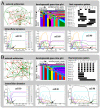Evolution of networks for body plan patterning; interplay of modularity, robustness and evolvability
- PMID: 21998573
- PMCID: PMC3188509
- DOI: 10.1371/journal.pcbi.1002208
Evolution of networks for body plan patterning; interplay of modularity, robustness and evolvability
Abstract
A major goal of evolutionary developmental biology (evo-devo) is to understand how multicellular body plans of increasing complexity have evolved, and how the corresponding developmental programs are genetically encoded. It has been repeatedly argued that key to the evolution of increased body plan complexity is the modularity of the underlying developmental gene regulatory networks (GRNs). This modularity is considered essential for network robustness and evolvability. In our opinion, these ideas, appealing as they may sound, have not been sufficiently tested. Here we use computer simulations to study the evolution of GRNs' underlying body plan patterning. We select for body plan segmentation and differentiation, as these are considered to be major innovations in metazoan evolution. To allow modular networks to evolve, we independently select for segmentation and differentiation. We study both the occurrence and relation of robustness, evolvability and modularity of evolved networks. Interestingly, we observed two distinct evolutionary strategies to evolve a segmented, differentiated body plan. In the first strategy, first segments and then differentiation domains evolve (SF strategy). In the second scenario segments and domains evolve simultaneously (SS strategy). We demonstrate that under indirect selection for robustness the SF strategy becomes dominant. In addition, as a byproduct of this larger robustness, the SF strategy is also more evolvable. Finally, using a combined functional and architectural approach, we determine network modularity. We find that while SS networks generate segments and domains in an integrated manner, SF networks use largely independent modules to produce segments and domains. Surprisingly, we find that widely used, purely architectural methods for determining network modularity completely fail to establish this higher modularity of SF networks. Finally, we observe that, as a free side effect of evolving segmentation and differentiation in combination, we obtained in-silico developmental mechanisms resembling mechanisms used in vertebrate development.
Conflict of interest statement
The authors have declared that no competing interests exist.
Figures









Similar articles
-
On the role of sparseness in the evolution of modularity in gene regulatory networks.PLoS Comput Biol. 2018 May 18;14(5):e1006172. doi: 10.1371/journal.pcbi.1006172. eCollection 2018 May. PLoS Comput Biol. 2018. PMID: 29775459 Free PMC article.
-
Modular genetic regulatory networks increase organization during pattern formation.Biosystems. 2016 Aug;146:77-84. doi: 10.1016/j.biosystems.2016.04.004. Epub 2016 Jun 17. Biosystems. 2016. PMID: 27327866
-
On the effects of the modularity of gene regulatory networks on phenotypic variability and its association with robustness.Biosystems. 2022 Feb;212:104586. doi: 10.1016/j.biosystems.2021.104586. Epub 2021 Dec 28. Biosystems. 2022. PMID: 34971735
-
Using evolutionary computations to understand the design and evolution of gene and cell regulatory networks.Methods. 2013 Jul 15;62(1):39-55. doi: 10.1016/j.ymeth.2013.05.013. Epub 2013 May 30. Methods. 2013. PMID: 23726941 Free PMC article. Review.
-
Systems approaches in understanding evolution and evolvability.Prog Biophys Mol Biol. 2013 Dec;113(3):369-74. doi: 10.1016/j.pbiomolbio.2013.09.004. Epub 2013 Oct 9. Prog Biophys Mol Biol. 2013. PMID: 24120732 Review.
Cited by
-
A complex systems approach to Arabidopsis root stem-cell niche developmental mechanisms: from molecules, to networks, to morphogenesis.Plant Mol Biol. 2012 Nov;80(4-5):351-63. doi: 10.1007/s11103-012-9954-6. Epub 2012 Sep 4. Plant Mol Biol. 2012. PMID: 22945341 Review.
-
A spectrum of modularity in multi-functional gene circuits.Mol Syst Biol. 2017 Apr 27;13(4):925. doi: 10.15252/msb.20167347. Mol Syst Biol. 2017. PMID: 28455348 Free PMC article.
-
AI-driven automated discovery tools reveal diverse behavioral competencies of biological networks.Elife. 2025 Jan 13;13:RP92683. doi: 10.7554/eLife.92683. Elife. 2025. PMID: 39804159 Free PMC article.
-
Harnessing the analog computing power of regulatory networks with the Regulatory Network Machine.iScience. 2025 Apr 28;28(6):112536. doi: 10.1016/j.isci.2025.112536. eCollection 2025 Jun 20. iScience. 2025. PMID: 40600146 Free PMC article.
-
Associative conditioning in gene regulatory network models increases integrative causal emergence.Commun Biol. 2025 Jul 9;8(1):1027. doi: 10.1038/s42003-025-08411-2. Commun Biol. 2025. PMID: 40634498 Free PMC article.
References
-
- Wilkins A. Sinauer; 2002. The Evolution of Developmental Pathways.
-
- Davidson E. Academic Press; 2006. The Regulatory Genome.
-
- Wolpert L. Oxford University Press; 2007. Principles of Development.
-
- Tautz D. Evolution of transcriptional regulation. Curr Opin Genet Dev. 2000;10:575–579. - PubMed
-
- Levine M, Tjian R. Transcription regulation and animal diversity. Nature. 2003;424:147–151. - PubMed
Publication types
MeSH terms
LinkOut - more resources
Full Text Sources

